NUR 120: Analyzing Ethical and Legal Issues in Nursing Practice
VerifiedAdded on 2023/06/13
|7
|2656
|219
Essay
AI Summary
This essay addresses the ethical and legal implications of a nursing student being asked to forge a classmate's signature on an attendance list. It emphasizes the importance of upholding the Australian Registered Nurse Standards for Practice and the ICN Code of Ethics. The immediate action involves refusing the request and educating the colleague about the potential consequences. Subsequent actions include reporting the incident to a supervisor if the behavior persists. The essay highlights the legal ramifications of forgery, including potential suspension, deregistration, fines, or imprisonment. It underscores the role of nurses as patient advocates, guided by principles of dignity, responsibility, and communication. The essay also explores the values and competencies expected of registered nurses, such as professionalism, critical thinking, and the ability to provide coordinated and ethical care. The conclusion reinforces the need for nurses to adhere to ethical codes and legal regulations to ensure patient safety and maintain the integrity of the profession.
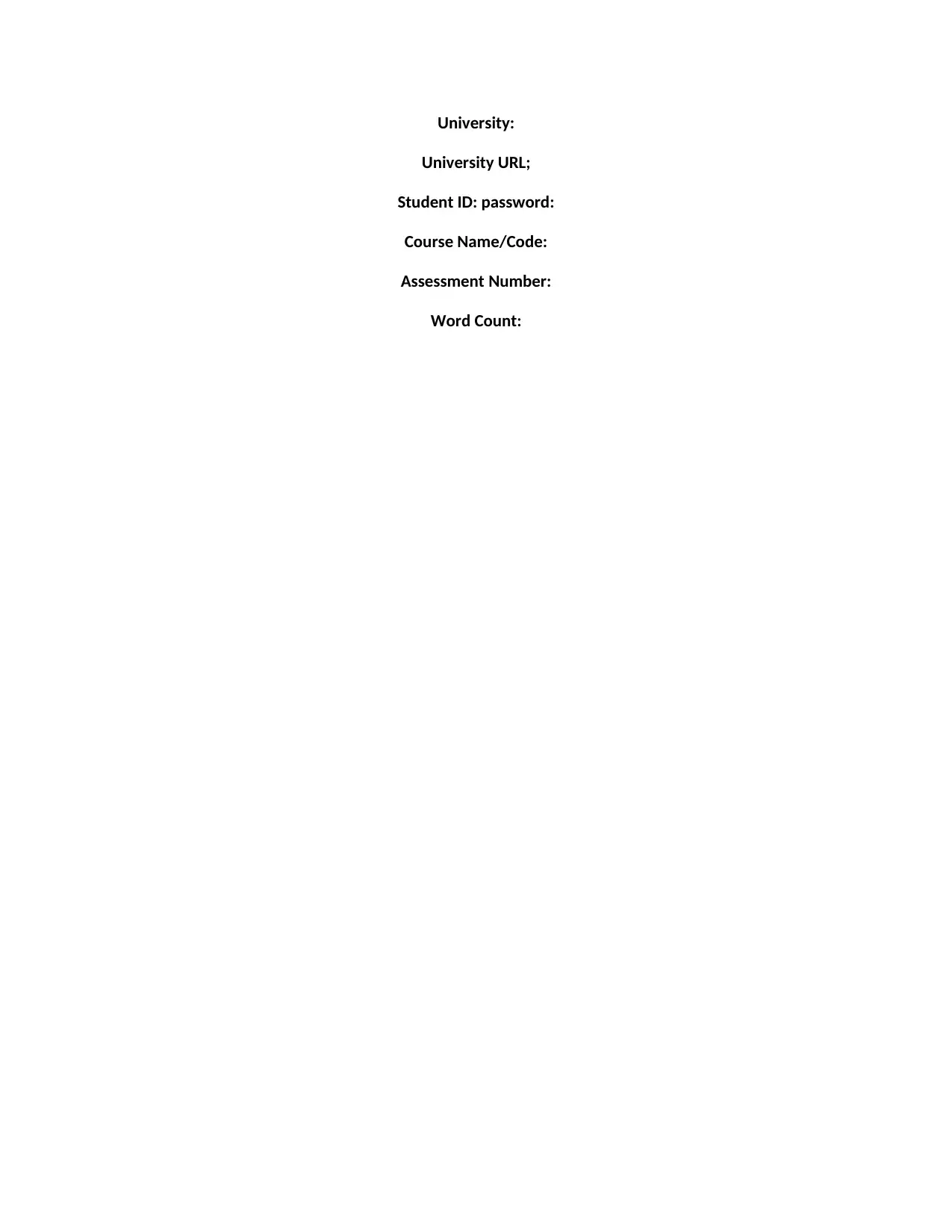
University:
University URL;
Student ID: password:
Course Name/Code:
Assessment Number:
Word Count:
University URL;
Student ID: password:
Course Name/Code:
Assessment Number:
Word Count:
Secure Best Marks with AI Grader
Need help grading? Try our AI Grader for instant feedback on your assignments.
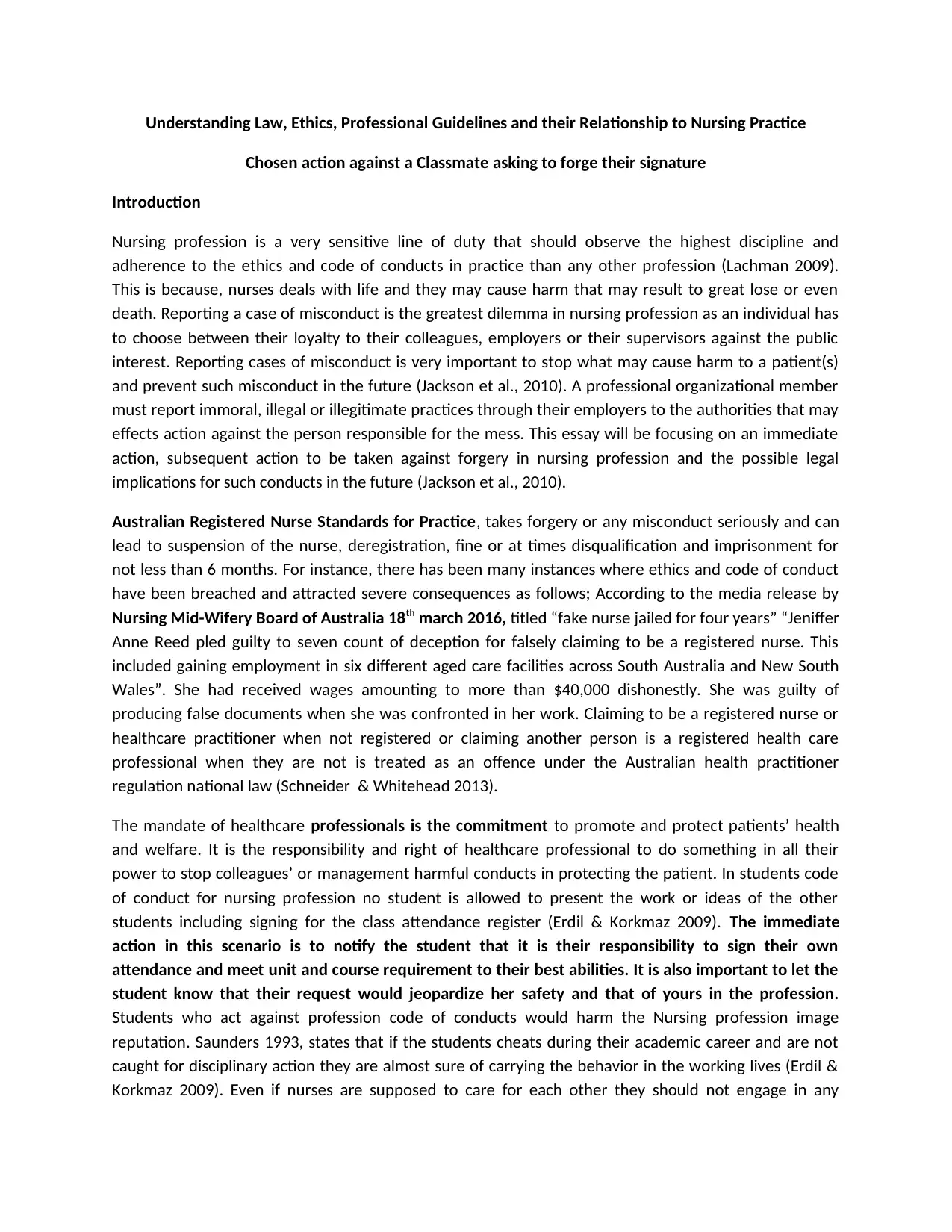
Understanding Law, Ethics, Professional Guidelines and their Relationship to Nursing Practice
Chosen action against a Classmate asking to forge their signature
Introduction
Nursing profession is a very sensitive line of duty that should observe the highest discipline and
adherence to the ethics and code of conducts in practice than any other profession (Lachman 2009).
This is because, nurses deals with life and they may cause harm that may result to great lose or even
death. Reporting a case of misconduct is the greatest dilemma in nursing profession as an individual has
to choose between their loyalty to their colleagues, employers or their supervisors against the public
interest. Reporting cases of misconduct is very important to stop what may cause harm to a patient(s)
and prevent such misconduct in the future (Jackson et al., 2010). A professional organizational member
must report immoral, illegal or illegitimate practices through their employers to the authorities that may
effects action against the person responsible for the mess. This essay will be focusing on an immediate
action, subsequent action to be taken against forgery in nursing profession and the possible legal
implications for such conducts in the future (Jackson et al., 2010).
Australian Registered Nurse Standards for Practice, takes forgery or any misconduct seriously and can
lead to suspension of the nurse, deregistration, fine or at times disqualification and imprisonment for
not less than 6 months. For instance, there has been many instances where ethics and code of conduct
have been breached and attracted severe consequences as follows; According to the media release by
Nursing Mid-Wifery Board of Australia 18th march 2016, titled “fake nurse jailed for four years” “Jeniffer
Anne Reed pled guilty to seven count of deception for falsely claiming to be a registered nurse. This
included gaining employment in six different aged care facilities across South Australia and New South
Wales”. She had received wages amounting to more than $40,000 dishonestly. She was guilty of
producing false documents when she was confronted in her work. Claiming to be a registered nurse or
healthcare practitioner when not registered or claiming another person is a registered health care
professional when they are not is treated as an offence under the Australian health practitioner
regulation national law (Schneider & Whitehead 2013).
The mandate of healthcare professionals is the commitment to promote and protect patients’ health
and welfare. It is the responsibility and right of healthcare professional to do something in all their
power to stop colleagues’ or management harmful conducts in protecting the patient. In students code
of conduct for nursing profession no student is allowed to present the work or ideas of the other
students including signing for the class attendance register (Erdil & Korkmaz 2009). The immediate
action in this scenario is to notify the student that it is their responsibility to sign their own
attendance and meet unit and course requirement to their best abilities. It is also important to let the
student know that their request would jeopardize her safety and that of yours in the profession.
Students who act against profession code of conducts would harm the Nursing profession image
reputation. Saunders 1993, states that if the students cheats during their academic career and are not
caught for disciplinary action they are almost sure of carrying the behavior in the working lives (Erdil &
Korkmaz 2009). Even if nurses are supposed to care for each other they should not engage in any
Chosen action against a Classmate asking to forge their signature
Introduction
Nursing profession is a very sensitive line of duty that should observe the highest discipline and
adherence to the ethics and code of conducts in practice than any other profession (Lachman 2009).
This is because, nurses deals with life and they may cause harm that may result to great lose or even
death. Reporting a case of misconduct is the greatest dilemma in nursing profession as an individual has
to choose between their loyalty to their colleagues, employers or their supervisors against the public
interest. Reporting cases of misconduct is very important to stop what may cause harm to a patient(s)
and prevent such misconduct in the future (Jackson et al., 2010). A professional organizational member
must report immoral, illegal or illegitimate practices through their employers to the authorities that may
effects action against the person responsible for the mess. This essay will be focusing on an immediate
action, subsequent action to be taken against forgery in nursing profession and the possible legal
implications for such conducts in the future (Jackson et al., 2010).
Australian Registered Nurse Standards for Practice, takes forgery or any misconduct seriously and can
lead to suspension of the nurse, deregistration, fine or at times disqualification and imprisonment for
not less than 6 months. For instance, there has been many instances where ethics and code of conduct
have been breached and attracted severe consequences as follows; According to the media release by
Nursing Mid-Wifery Board of Australia 18th march 2016, titled “fake nurse jailed for four years” “Jeniffer
Anne Reed pled guilty to seven count of deception for falsely claiming to be a registered nurse. This
included gaining employment in six different aged care facilities across South Australia and New South
Wales”. She had received wages amounting to more than $40,000 dishonestly. She was guilty of
producing false documents when she was confronted in her work. Claiming to be a registered nurse or
healthcare practitioner when not registered or claiming another person is a registered health care
professional when they are not is treated as an offence under the Australian health practitioner
regulation national law (Schneider & Whitehead 2013).
The mandate of healthcare professionals is the commitment to promote and protect patients’ health
and welfare. It is the responsibility and right of healthcare professional to do something in all their
power to stop colleagues’ or management harmful conducts in protecting the patient. In students code
of conduct for nursing profession no student is allowed to present the work or ideas of the other
students including signing for the class attendance register (Erdil & Korkmaz 2009). The immediate
action in this scenario is to notify the student that it is their responsibility to sign their own
attendance and meet unit and course requirement to their best abilities. It is also important to let the
student know that their request would jeopardize her safety and that of yours in the profession.
Students who act against profession code of conducts would harm the Nursing profession image
reputation. Saunders 1993, states that if the students cheats during their academic career and are not
caught for disciplinary action they are almost sure of carrying the behavior in the working lives (Erdil &
Korkmaz 2009). Even if nurses are supposed to care for each other they should not engage in any
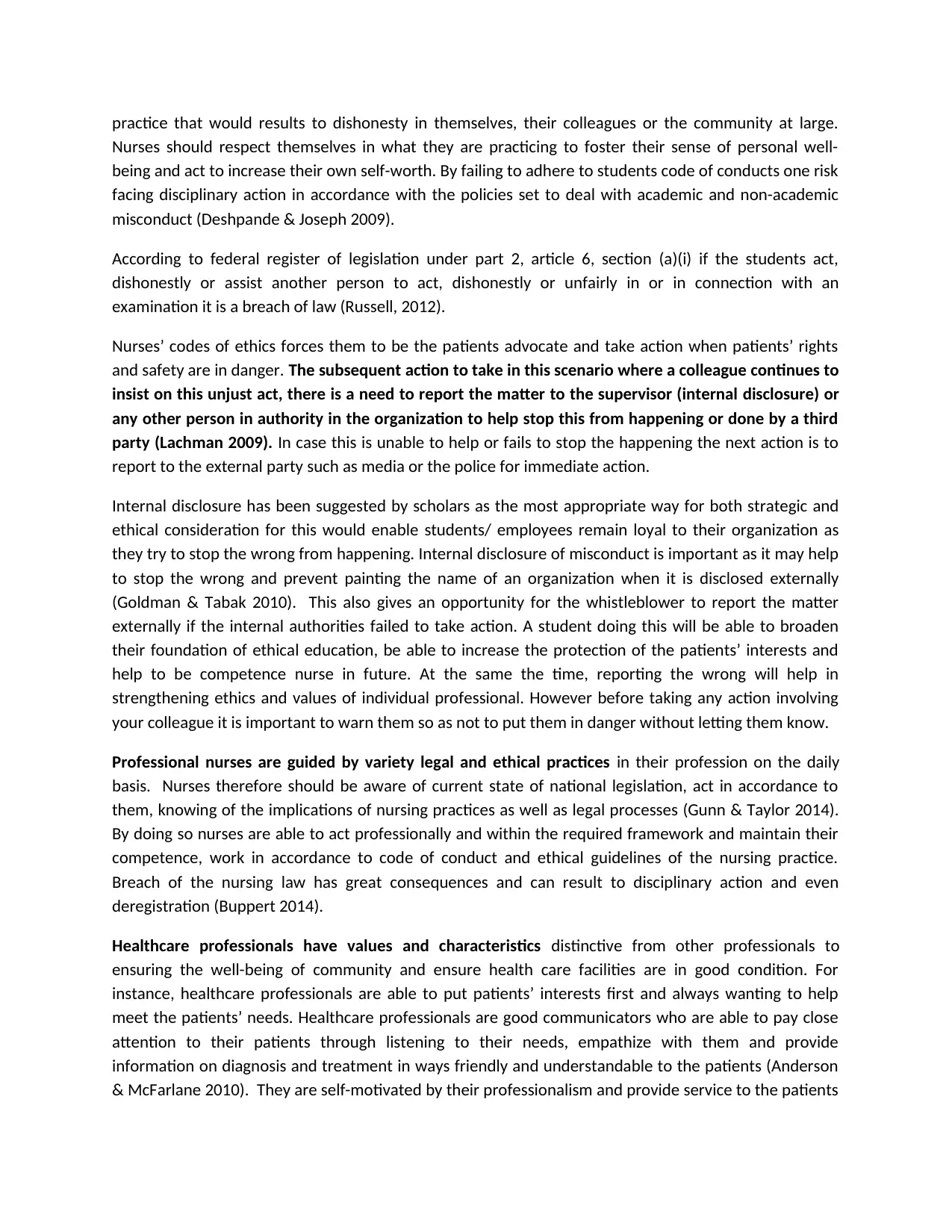
practice that would results to dishonesty in themselves, their colleagues or the community at large.
Nurses should respect themselves in what they are practicing to foster their sense of personal well-
being and act to increase their own self-worth. By failing to adhere to students code of conducts one risk
facing disciplinary action in accordance with the policies set to deal with academic and non-academic
misconduct (Deshpande & Joseph 2009).
According to federal register of legislation under part 2, article 6, section (a)(i) if the students act,
dishonestly or assist another person to act, dishonestly or unfairly in or in connection with an
examination it is a breach of law (Russell, 2012).
Nurses’ codes of ethics forces them to be the patients advocate and take action when patients’ rights
and safety are in danger. The subsequent action to take in this scenario where a colleague continues to
insist on this unjust act, there is a need to report the matter to the supervisor (internal disclosure) or
any other person in authority in the organization to help stop this from happening or done by a third
party (Lachman 2009). In case this is unable to help or fails to stop the happening the next action is to
report to the external party such as media or the police for immediate action.
Internal disclosure has been suggested by scholars as the most appropriate way for both strategic and
ethical consideration for this would enable students/ employees remain loyal to their organization as
they try to stop the wrong from happening. Internal disclosure of misconduct is important as it may help
to stop the wrong and prevent painting the name of an organization when it is disclosed externally
(Goldman & Tabak 2010). This also gives an opportunity for the whistleblower to report the matter
externally if the internal authorities failed to take action. A student doing this will be able to broaden
their foundation of ethical education, be able to increase the protection of the patients’ interests and
help to be competence nurse in future. At the same the time, reporting the wrong will help in
strengthening ethics and values of individual professional. However before taking any action involving
your colleague it is important to warn them so as not to put them in danger without letting them know.
Professional nurses are guided by variety legal and ethical practices in their profession on the daily
basis. Nurses therefore should be aware of current state of national legislation, act in accordance to
them, knowing of the implications of nursing practices as well as legal processes (Gunn & Taylor 2014).
By doing so nurses are able to act professionally and within the required framework and maintain their
competence, work in accordance to code of conduct and ethical guidelines of the nursing practice.
Breach of the nursing law has great consequences and can result to disciplinary action and even
deregistration (Buppert 2014).
Healthcare professionals have values and characteristics distinctive from other professionals to
ensuring the well-being of community and ensure health care facilities are in good condition. For
instance, healthcare professionals are able to put patients’ interests first and always wanting to help
meet the patients’ needs. Healthcare professionals are good communicators who are able to pay close
attention to their patients through listening to their needs, empathize with them and provide
information on diagnosis and treatment in ways friendly and understandable to the patients (Anderson
& McFarlane 2010). They are self-motivated by their professionalism and provide service to the patients
Nurses should respect themselves in what they are practicing to foster their sense of personal well-
being and act to increase their own self-worth. By failing to adhere to students code of conducts one risk
facing disciplinary action in accordance with the policies set to deal with academic and non-academic
misconduct (Deshpande & Joseph 2009).
According to federal register of legislation under part 2, article 6, section (a)(i) if the students act,
dishonestly or assist another person to act, dishonestly or unfairly in or in connection with an
examination it is a breach of law (Russell, 2012).
Nurses’ codes of ethics forces them to be the patients advocate and take action when patients’ rights
and safety are in danger. The subsequent action to take in this scenario where a colleague continues to
insist on this unjust act, there is a need to report the matter to the supervisor (internal disclosure) or
any other person in authority in the organization to help stop this from happening or done by a third
party (Lachman 2009). In case this is unable to help or fails to stop the happening the next action is to
report to the external party such as media or the police for immediate action.
Internal disclosure has been suggested by scholars as the most appropriate way for both strategic and
ethical consideration for this would enable students/ employees remain loyal to their organization as
they try to stop the wrong from happening. Internal disclosure of misconduct is important as it may help
to stop the wrong and prevent painting the name of an organization when it is disclosed externally
(Goldman & Tabak 2010). This also gives an opportunity for the whistleblower to report the matter
externally if the internal authorities failed to take action. A student doing this will be able to broaden
their foundation of ethical education, be able to increase the protection of the patients’ interests and
help to be competence nurse in future. At the same the time, reporting the wrong will help in
strengthening ethics and values of individual professional. However before taking any action involving
your colleague it is important to warn them so as not to put them in danger without letting them know.
Professional nurses are guided by variety legal and ethical practices in their profession on the daily
basis. Nurses therefore should be aware of current state of national legislation, act in accordance to
them, knowing of the implications of nursing practices as well as legal processes (Gunn & Taylor 2014).
By doing so nurses are able to act professionally and within the required framework and maintain their
competence, work in accordance to code of conduct and ethical guidelines of the nursing practice.
Breach of the nursing law has great consequences and can result to disciplinary action and even
deregistration (Buppert 2014).
Healthcare professionals have values and characteristics distinctive from other professionals to
ensuring the well-being of community and ensure health care facilities are in good condition. For
instance, healthcare professionals are able to put patients’ interests first and always wanting to help
meet the patients’ needs. Healthcare professionals are good communicators who are able to pay close
attention to their patients through listening to their needs, empathize with them and provide
information on diagnosis and treatment in ways friendly and understandable to the patients (Anderson
& McFarlane 2010). They are self-motivated by their professionalism and provide service to the patients
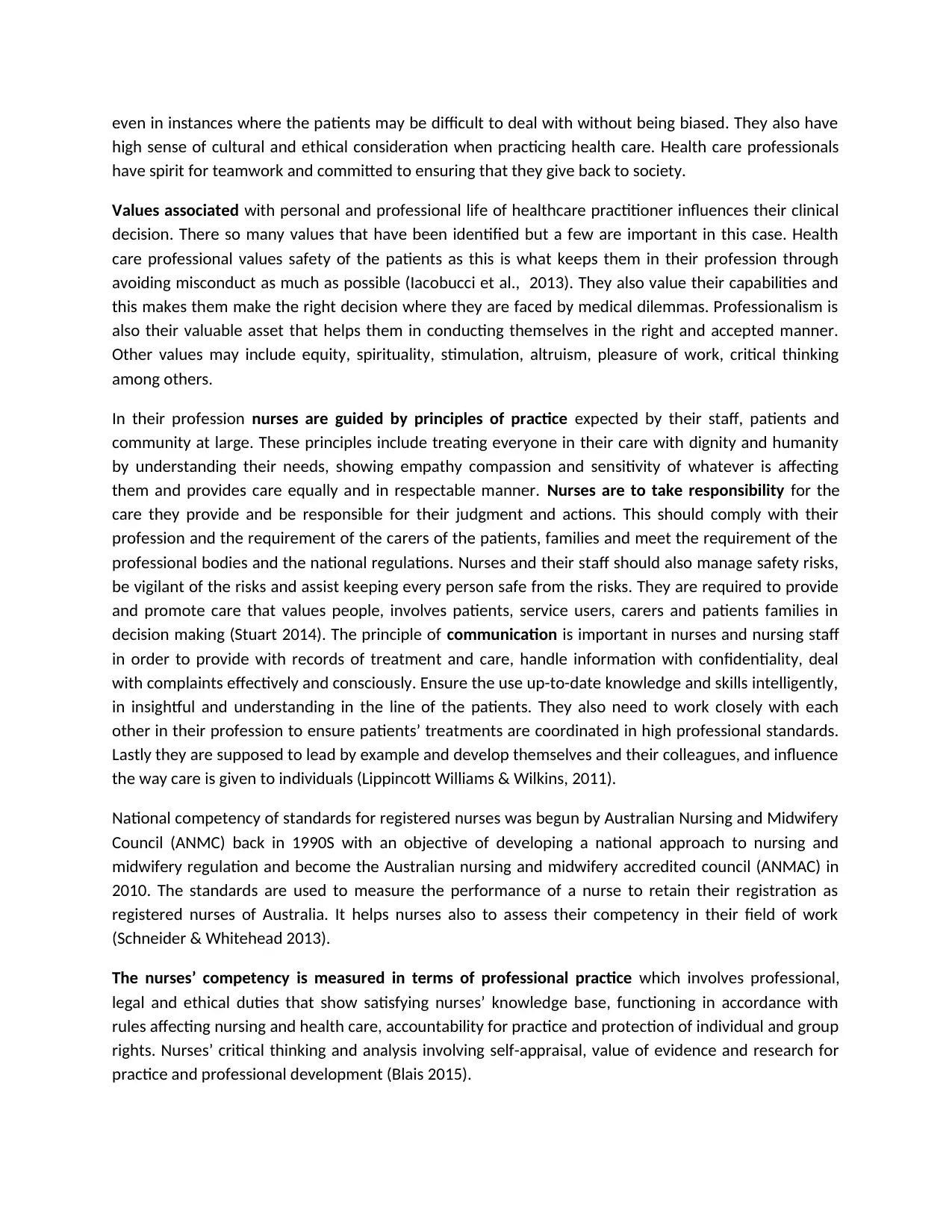
even in instances where the patients may be difficult to deal with without being biased. They also have
high sense of cultural and ethical consideration when practicing health care. Health care professionals
have spirit for teamwork and committed to ensuring that they give back to society.
Values associated with personal and professional life of healthcare practitioner influences their clinical
decision. There so many values that have been identified but a few are important in this case. Health
care professional values safety of the patients as this is what keeps them in their profession through
avoiding misconduct as much as possible (Iacobucci et al., 2013). They also value their capabilities and
this makes them make the right decision where they are faced by medical dilemmas. Professionalism is
also their valuable asset that helps them in conducting themselves in the right and accepted manner.
Other values may include equity, spirituality, stimulation, altruism, pleasure of work, critical thinking
among others.
In their profession nurses are guided by principles of practice expected by their staff, patients and
community at large. These principles include treating everyone in their care with dignity and humanity
by understanding their needs, showing empathy compassion and sensitivity of whatever is affecting
them and provides care equally and in respectable manner. Nurses are to take responsibility for the
care they provide and be responsible for their judgment and actions. This should comply with their
profession and the requirement of the carers of the patients, families and meet the requirement of the
professional bodies and the national regulations. Nurses and their staff should also manage safety risks,
be vigilant of the risks and assist keeping every person safe from the risks. They are required to provide
and promote care that values people, involves patients, service users, carers and patients families in
decision making (Stuart 2014). The principle of communication is important in nurses and nursing staff
in order to provide with records of treatment and care, handle information with confidentiality, deal
with complaints effectively and consciously. Ensure the use up-to-date knowledge and skills intelligently,
in insightful and understanding in the line of the patients. They also need to work closely with each
other in their profession to ensure patients’ treatments are coordinated in high professional standards.
Lastly they are supposed to lead by example and develop themselves and their colleagues, and influence
the way care is given to individuals (Lippincott Williams & Wilkins, 2011).
National competency of standards for registered nurses was begun by Australian Nursing and Midwifery
Council (ANMC) back in 1990S with an objective of developing a national approach to nursing and
midwifery regulation and become the Australian nursing and midwifery accredited council (ANMAC) in
2010. The standards are used to measure the performance of a nurse to retain their registration as
registered nurses of Australia. It helps nurses also to assess their competency in their field of work
(Schneider & Whitehead 2013).
The nurses’ competency is measured in terms of professional practice which involves professional,
legal and ethical duties that show satisfying nurses’ knowledge base, functioning in accordance with
rules affecting nursing and health care, accountability for practice and protection of individual and group
rights. Nurses’ critical thinking and analysis involving self-appraisal, value of evidence and research for
practice and professional development (Blais 2015).
high sense of cultural and ethical consideration when practicing health care. Health care professionals
have spirit for teamwork and committed to ensuring that they give back to society.
Values associated with personal and professional life of healthcare practitioner influences their clinical
decision. There so many values that have been identified but a few are important in this case. Health
care professional values safety of the patients as this is what keeps them in their profession through
avoiding misconduct as much as possible (Iacobucci et al., 2013). They also value their capabilities and
this makes them make the right decision where they are faced by medical dilemmas. Professionalism is
also their valuable asset that helps them in conducting themselves in the right and accepted manner.
Other values may include equity, spirituality, stimulation, altruism, pleasure of work, critical thinking
among others.
In their profession nurses are guided by principles of practice expected by their staff, patients and
community at large. These principles include treating everyone in their care with dignity and humanity
by understanding their needs, showing empathy compassion and sensitivity of whatever is affecting
them and provides care equally and in respectable manner. Nurses are to take responsibility for the
care they provide and be responsible for their judgment and actions. This should comply with their
profession and the requirement of the carers of the patients, families and meet the requirement of the
professional bodies and the national regulations. Nurses and their staff should also manage safety risks,
be vigilant of the risks and assist keeping every person safe from the risks. They are required to provide
and promote care that values people, involves patients, service users, carers and patients families in
decision making (Stuart 2014). The principle of communication is important in nurses and nursing staff
in order to provide with records of treatment and care, handle information with confidentiality, deal
with complaints effectively and consciously. Ensure the use up-to-date knowledge and skills intelligently,
in insightful and understanding in the line of the patients. They also need to work closely with each
other in their profession to ensure patients’ treatments are coordinated in high professional standards.
Lastly they are supposed to lead by example and develop themselves and their colleagues, and influence
the way care is given to individuals (Lippincott Williams & Wilkins, 2011).
National competency of standards for registered nurses was begun by Australian Nursing and Midwifery
Council (ANMC) back in 1990S with an objective of developing a national approach to nursing and
midwifery regulation and become the Australian nursing and midwifery accredited council (ANMAC) in
2010. The standards are used to measure the performance of a nurse to retain their registration as
registered nurses of Australia. It helps nurses also to assess their competency in their field of work
(Schneider & Whitehead 2013).
The nurses’ competency is measured in terms of professional practice which involves professional,
legal and ethical duties that show satisfying nurses’ knowledge base, functioning in accordance with
rules affecting nursing and health care, accountability for practice and protection of individual and group
rights. Nurses’ critical thinking and analysis involving self-appraisal, value of evidence and research for
practice and professional development (Blais 2015).
Secure Best Marks with AI Grader
Need help grading? Try our AI Grader for instant feedback on your assignments.
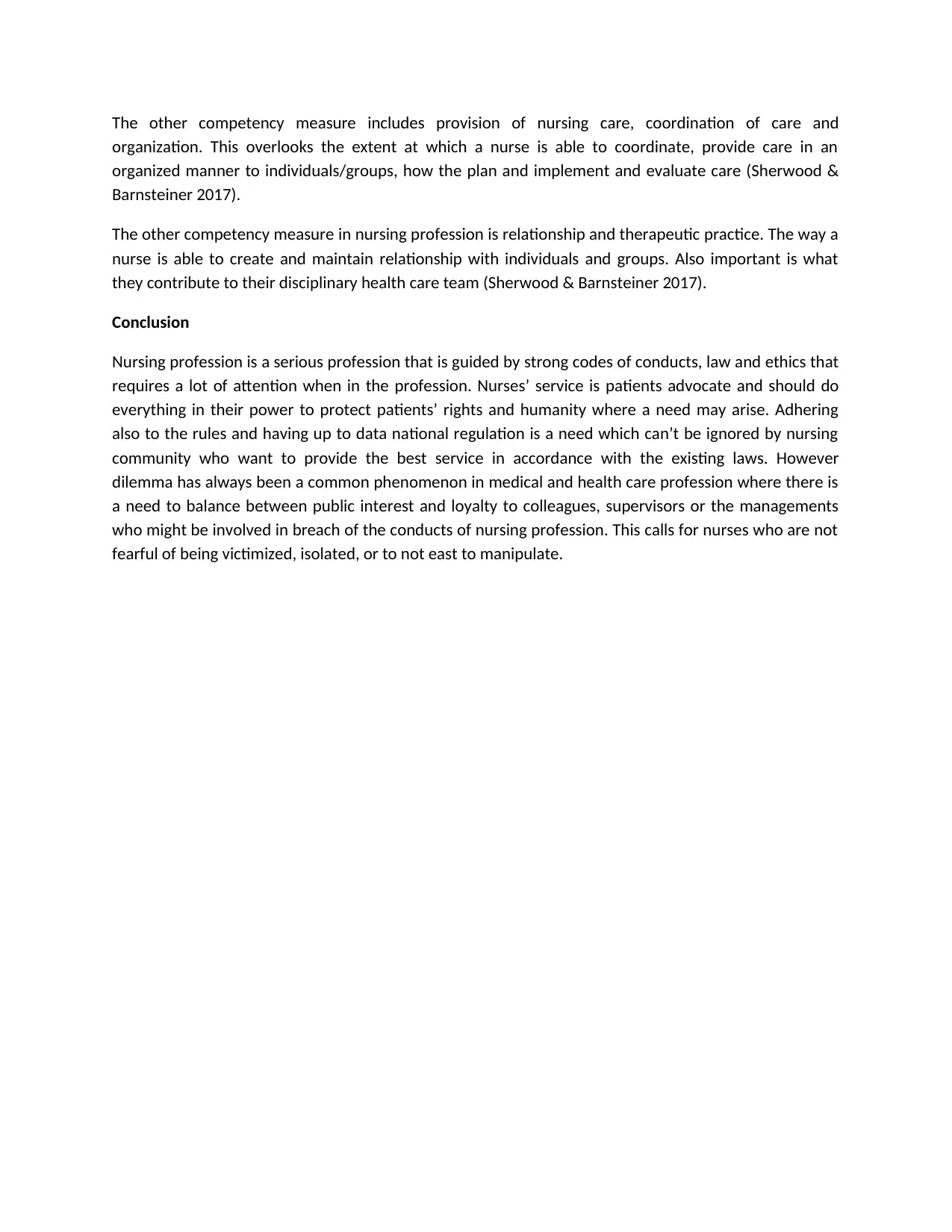
The other competency measure includes provision of nursing care, coordination of care and
organization. This overlooks the extent at which a nurse is able to coordinate, provide care in an
organized manner to individuals/groups, how the plan and implement and evaluate care (Sherwood &
Barnsteiner 2017).
The other competency measure in nursing profession is relationship and therapeutic practice. The way a
nurse is able to create and maintain relationship with individuals and groups. Also important is what
they contribute to their disciplinary health care team (Sherwood & Barnsteiner 2017).
Conclusion
Nursing profession is a serious profession that is guided by strong codes of conducts, law and ethics that
requires a lot of attention when in the profession. Nurses’ service is patients advocate and should do
everything in their power to protect patients’ rights and humanity where a need may arise. Adhering
also to the rules and having up to data national regulation is a need which can’t be ignored by nursing
community who want to provide the best service in accordance with the existing laws. However
dilemma has always been a common phenomenon in medical and health care profession where there is
a need to balance between public interest and loyalty to colleagues, supervisors or the managements
who might be involved in breach of the conducts of nursing profession. This calls for nurses who are not
fearful of being victimized, isolated, or to not east to manipulate.
organization. This overlooks the extent at which a nurse is able to coordinate, provide care in an
organized manner to individuals/groups, how the plan and implement and evaluate care (Sherwood &
Barnsteiner 2017).
The other competency measure in nursing profession is relationship and therapeutic practice. The way a
nurse is able to create and maintain relationship with individuals and groups. Also important is what
they contribute to their disciplinary health care team (Sherwood & Barnsteiner 2017).
Conclusion
Nursing profession is a serious profession that is guided by strong codes of conducts, law and ethics that
requires a lot of attention when in the profession. Nurses’ service is patients advocate and should do
everything in their power to protect patients’ rights and humanity where a need may arise. Adhering
also to the rules and having up to data national regulation is a need which can’t be ignored by nursing
community who want to provide the best service in accordance with the existing laws. However
dilemma has always been a common phenomenon in medical and health care profession where there is
a need to balance between public interest and loyalty to colleagues, supervisors or the managements
who might be involved in breach of the conducts of nursing profession. This calls for nurses who are not
fearful of being victimized, isolated, or to not east to manipulate.

References
Anderson, E. T., & McFarlane, J. M. (2010). Community as partner: Theory and practice in nursing.
Lippincott Williams & Wilkins.
Blais, K. (2015). Professional nursing practice: Concepts and perspectives. Pearson.
Buppert, C. (2014). Nurse practitioner's business practice and legal guide. Jones & Bartlett Publishers.
Deshpande, S. P., & Joseph, J. (2009). Impact of emotional intelligence, ethical climate, and behavior of
peers on ethical behavior of nurses. Journal of Business Ethics, 85(3), 403.
Erdil, F., & Korkmaz, F. (2009). Ethical problems observed by student nurses. Nursing ethics, 16(5), 589-
598.
Goldman, A., & Tabak, N. (2010). Perception of ethical climate and its relationship to nurses’
demographic characteristics and job satisfaction. Nursing Ethics, 17(2), 233-246.
Gunn, J., & Taylor, P. (2014). Forensic psychiatry: clinical, legal and ethical issues. CRC Press.
Jackson, D., Peters, K., Andrew, S., Edenborough, M., Halcomb, E., Luck, L., ... & Wilkes, L. (2010).
Understanding whistleblowing: qualitative insights from nurse whistleblowers. Journal of
Advanced Nursing, 66(10), 2194-2201.
Lachman, V. D. (2009). Practical use of the nursing code of ethics: Part I. MedSurg Nursing, 18(1), 55.
Iacobucci, T. A., Daly, B. J., Lindell, D., & Griffin, M. Q. (2013). Professional values, self-esteem, and
ethical confidence of baccalaureate nursing students. Nursing ethics, 20(4), 479-490.
Lippincott Williams & Wilkins, 2011. Melnyk, Bernadette Mazurek, and Ellen Fineout-Overholt, eds.
Evidence-based practice in nursing & healthcare: A guide to best practice.
Russell, K. A. (2012). Nurse practice acts guide and govern nursing practice. Journal of Nursing
Regulation, 3(3), 36-42.
Anderson, E. T., & McFarlane, J. M. (2010). Community as partner: Theory and practice in nursing.
Lippincott Williams & Wilkins.
Blais, K. (2015). Professional nursing practice: Concepts and perspectives. Pearson.
Buppert, C. (2014). Nurse practitioner's business practice and legal guide. Jones & Bartlett Publishers.
Deshpande, S. P., & Joseph, J. (2009). Impact of emotional intelligence, ethical climate, and behavior of
peers on ethical behavior of nurses. Journal of Business Ethics, 85(3), 403.
Erdil, F., & Korkmaz, F. (2009). Ethical problems observed by student nurses. Nursing ethics, 16(5), 589-
598.
Goldman, A., & Tabak, N. (2010). Perception of ethical climate and its relationship to nurses’
demographic characteristics and job satisfaction. Nursing Ethics, 17(2), 233-246.
Gunn, J., & Taylor, P. (2014). Forensic psychiatry: clinical, legal and ethical issues. CRC Press.
Jackson, D., Peters, K., Andrew, S., Edenborough, M., Halcomb, E., Luck, L., ... & Wilkes, L. (2010).
Understanding whistleblowing: qualitative insights from nurse whistleblowers. Journal of
Advanced Nursing, 66(10), 2194-2201.
Lachman, V. D. (2009). Practical use of the nursing code of ethics: Part I. MedSurg Nursing, 18(1), 55.
Iacobucci, T. A., Daly, B. J., Lindell, D., & Griffin, M. Q. (2013). Professional values, self-esteem, and
ethical confidence of baccalaureate nursing students. Nursing ethics, 20(4), 479-490.
Lippincott Williams & Wilkins, 2011. Melnyk, Bernadette Mazurek, and Ellen Fineout-Overholt, eds.
Evidence-based practice in nursing & healthcare: A guide to best practice.
Russell, K. A. (2012). Nurse practice acts guide and govern nursing practice. Journal of Nursing
Regulation, 3(3), 36-42.
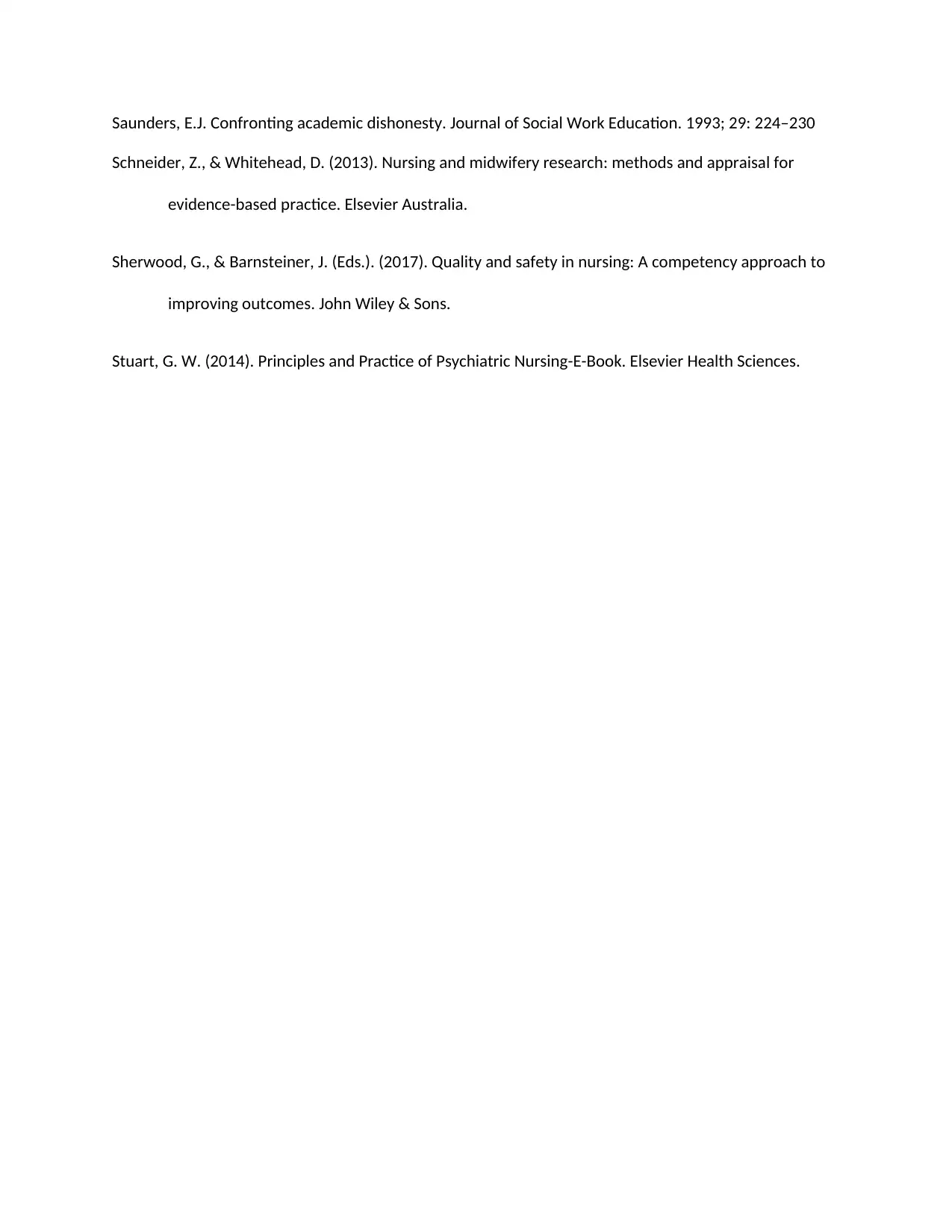
Saunders, E.J. Confronting academic dishonesty. Journal of Social Work Education. 1993; 29: 224–230
Schneider, Z., & Whitehead, D. (2013). Nursing and midwifery research: methods and appraisal for
evidence-based practice. Elsevier Australia.
Sherwood, G., & Barnsteiner, J. (Eds.). (2017). Quality and safety in nursing: A competency approach to
improving outcomes. John Wiley & Sons.
Stuart, G. W. (2014). Principles and Practice of Psychiatric Nursing-E-Book. Elsevier Health Sciences.
Schneider, Z., & Whitehead, D. (2013). Nursing and midwifery research: methods and appraisal for
evidence-based practice. Elsevier Australia.
Sherwood, G., & Barnsteiner, J. (Eds.). (2017). Quality and safety in nursing: A competency approach to
improving outcomes. John Wiley & Sons.
Stuart, G. W. (2014). Principles and Practice of Psychiatric Nursing-E-Book. Elsevier Health Sciences.
1 out of 7
Related Documents
Your All-in-One AI-Powered Toolkit for Academic Success.
+13062052269
info@desklib.com
Available 24*7 on WhatsApp / Email
![[object Object]](/_next/static/media/star-bottom.7253800d.svg)
Unlock your academic potential
© 2024 | Zucol Services PVT LTD | All rights reserved.





